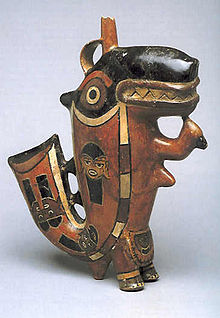Nazca kultura
Prijeđi na navigaciju
Prijeđi na pretragu

Nazca kultura (također Nasca) je arheološka kultura koja je postojala od 100. do 800. n.e. na južnoj obali Perua, odnosno u porječju Rio Grande de Nazca i dolini Ica Valley (Silverman and Proulx, 2002). Na nju je snažno uticala ranija Paracas kultura, poznata po složenom tekstilu; Nazca kultura je, pak, proizvela niz impresivnih tehnoloških artefakata vezanih uz keramiku, tekstil te geoglife (od kojih su najpoznatije Nazca linije). Također je sagradila impresivni sistem podzemnih akvedukta, poznatih kao puquios, od kojih su neki i danas u upotrebi. Po toj kulturi i narodu je nazvana provincija Nazca u regiji Ica.
Izvori[uredi | uredi kod]
- The Incas and their Ancestors: The Archaeology of Peru by Michael E. Moseley. 1992.
- Cahuachi in the Ancient Nasca World Silverman, Helaine. University of Iowa Press. Iowa City. 1993.
- A Sourcebook of Nasca Ceramic Iconography by Donald A. Proulx (2006) University of Iowa Press
- From Monumental to Proliferous in Nasca Pottery by Richard Roark (1965) Nawpa Pacha 3:2
- The Nasca by Helaine Silverman and Donald A. Proulx. Blackwell Publishers. Malden. 2002.
- Ancient Nazca Settlement and Society by Helaine Silverman (2002) University of Iowa Press
- Local Differences and Time Differences in Nasca Pottery by Donald A. Proulx (1968) University of California Press
- "Cahuachi: New Evidence for an Early Nasca Ceremonial Role" by Lidio M. Valdez, Current Anthropology 35, no. 5 (December 1994): 675-679
- "The Archaeological Identification of an Ancient Peruvian Pilgrimage Center" by Helaine Silverman, World Archaeology 26, no. 1 (June 1994): 1-18
- "Ceramic Production in Ancient Nasca: Provenance Analysis of Pottery from the Early Nasca and Tiza Cultures Through INNA" by Kevin J. Vaughn, Journal of Archaeological Science (2006), Volume 33, Issue 5: 681-689
- "A Compositional Perspective on the Origins of the Nasca Cult at Cahuachi" by Kevin J. Vaughn, Journal of Archaeological Science (2007), Volume 34, Issue 5:814-822
- "Burial Patterns and Sociopolitical Organization in Nasca 5 Society" by William Harris and Helaine Silverman, Andean Archaeology III (2006), Volume 3:374-400
- "Cahuachi: Non-Urban Cultural Complexity on the South Coast of Peru" by Helaine Silverman, Journal of Field Archaeology (1988), Volume 15, No. 4:403-430
- "What the Women Were Wearing" by Mary Frame, Textile Museum Journal (2003/04), Volume 42-43:13-53
- "Households, Crafts and Feasting in the Ancient Andes: The Village Context of Early Nasca Craft Consumption" by Kevin J. Vaughn, Latin American Antiquity (2004), Volume 15, No. 1:61-88
- "A Cache of 48 Nasca Trophy Heads From Cerro Carapo, Peru" by David Browne, Helaine Silverman, and Ruben Garcia, Latin American Antiquity (1993), Volume 4, No. 3: 274-294
- "Paracas in Nazca: New data on the Early Horizon Occupation of the Rio Grande de drainage, Peru" Silverman, Helaine. (1994) Latin American Antiquity, Vol.5, No. 4, pp. 359–382.
- "The Puquios of Nasca" Schreiber, Katharina J. and Rojas, Josue Lancho. (1995) Latin American Antiquity. Vol. 6, No. 3, pp. 229–254.
- "Between the Lines: The Mystery of the Giant Ground Drawings of Ancient Nasca, Peru" Aveni, Anthony F. University of Texas Press. Austin. 2000.
- "New Chronometric Dates for the Puquios of Nasca, Peru" Clarkson, Persis B. and Dorn, Ronald I. (1995) Latin American Antiquity, Vol. 6, No. 1, pp. 56–69.
- "The body Context: Interpreting Early Nasca Decapitation Burials" DeLeonardis, Lisa. Latin American Antiquity. 2000. Vol. 11, No. 4, pp. 363–368.
- "Moving Beyond Iconography: Neutron Activation Analysis of Ceramics from Marcaya, Peru" Vaughn, Kevin J. and Neff, Hector. Journal of Field Archaeology. (2000) Vol. 27, No. 1, pp. 75–90.
- Early Nasca Needlework by Alan R. (1996) Sawyer Laurence King. ISBN 1-85669-088-1
- "The Role of Prosopis in Ecological and Landscape Change in the Samaca Basin, Lower Ica Valley, South Coast Peru from the Early Horizon to the Late Intermediate Period " by Beresford-Jones, D., S. Arce, O.Q. Whaley and A. Chepstow-Lusty (2009). Latin American Antiquity Vol. 20 pp. 303–33ian}}
